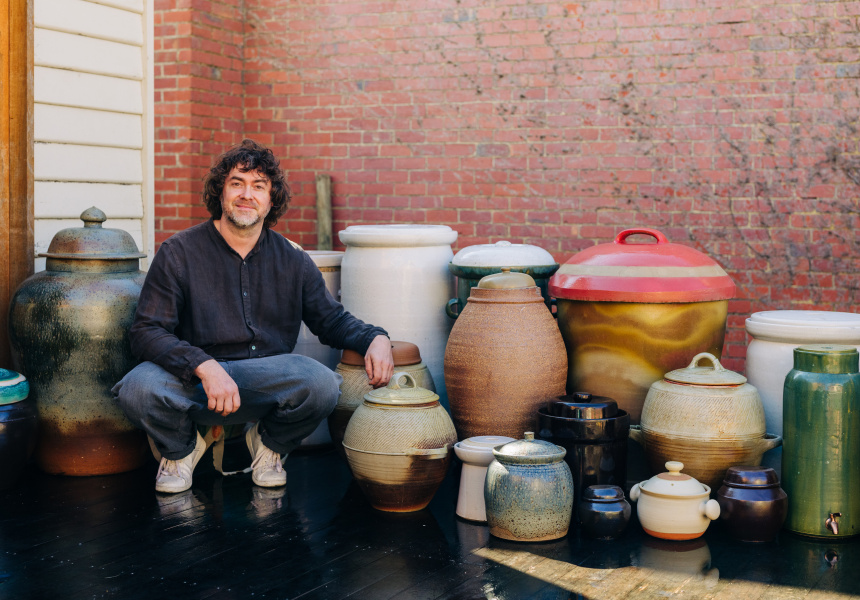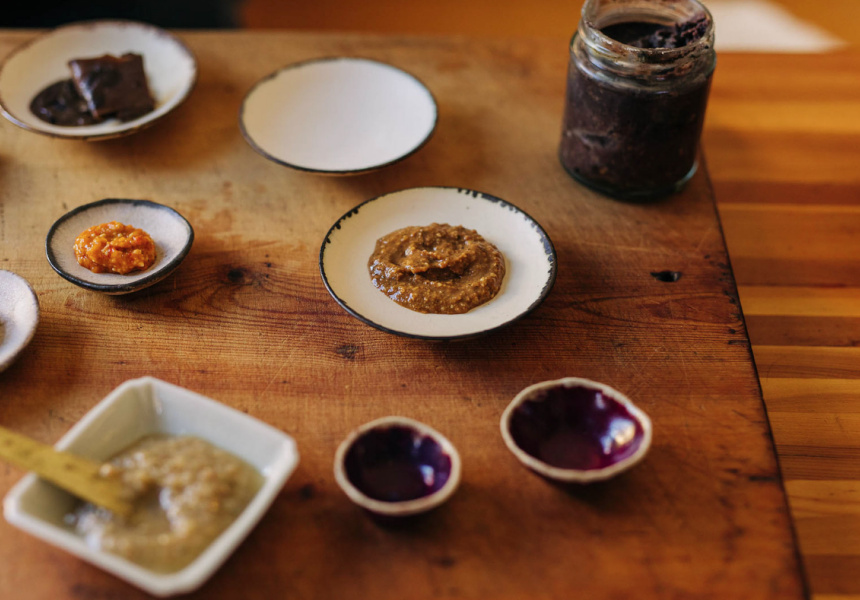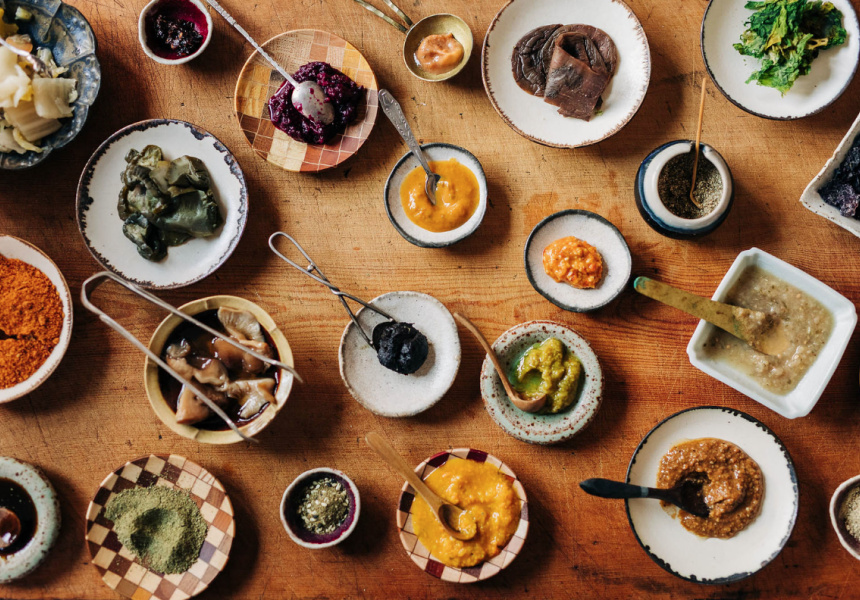Adam James has been fermenting for a long time. He used to make bootleg sambuca at boarding school in Adelaide, leaving it to develop under his bed for a couple of weeks before using it to barter with older students. From this auspicious beginning he’s turned fermentation into a career – albeit one with more wholesome aims.
Alcoholic possibilities aside, fermentation has traditionally been used to preserve food. For thousands of years, people of all cultures have put in the hard yards over summer, when there’s an oversupply of produce, and used the results to see the tribe through the leaner winter months. The list is extensive: pickles, salami, cheese, sauerkraut, kimchi, tempeh and more.
Fermentation, though, is also about creating interesting and complex flavours – especially so since the advent of technologies like refrigeration, pasteurisation and canning, which have lessened our reliance on the old ways. And it’s these unique flavours James is hooked on.
Years ago he owned a cafe in Hobart’s bustling Salamanca Place, where he’d receive an annual glut of produce from locals. He began using fermentation to deal with it, and soon became enthralled by the outcomes.
“The alchemy of starting with a raw vegetable and seeing it transition into something quite different is fascinating,” he says. (See his simple recipe for lacto-fermented blueberries, below.)
His tinkering led to him being awarded the prestigious Churchill Fellowship in 2016 and spending three months travelling and learning from masters of the craft in Denmark, Italy, France, Georgia, China, South Korea and Japan.
Today James’s business, Rough Rice, sells his wildly creative ferments online and at local markets, like Hobart’s Farm Gate. Drawing on his background as a chef, each one is made at his home, without added sugar, vinegar or stabilisers. Their popularity goes well beyond Hobart, and even Tasmania. James has fans all over the country, who snap up his limited releases in less than an hour. He’s Australia’s answer to American fermentation evangelist and author Sandor Katz.
A recent online drop was his angasi dashi, made from local native oysters, smoked skipjack tuna, seaweed and local fungi. He describes it as “miso soup meets the ocean”. Another concoction is his six-year-old “mothership” hot sauce. It lives in a locally made, 120-year-old crock and is fed consistently, like a sourdough starter, and never quite depleted. At last count there are more than 20 different varieties of fruit, veg and herbs in this ever-evolving beast.
James first arrived in Tasmania on a two-week trip that never really ended. He’s been here for 14 years now. The backyard of his Hobart cottage is a veritable fermentation hub, filled with crocks of his own design, in every size and shape.
Fermentation depends on temperature and therefore, weather. In summer everything is really active. When we speak it’s mid-autumn. His creations, involving lots of chillies, tomatoes, cucumbers and other summer bounty, are bubbling modestly. The crocks, he explains, are completely full and everything is starting to slow down now. With the initial fast fermentation complete, the cooler months, during Tasmania’s Off Season, are when the magic happens.
“I like to ferment things over winter and out the other side,” James says. “The delay allows the really interesting flavours and complexities to develop. I wouldn’t achieve that if I jarred things up now.”
While he’s flirted with the idea of getting a warehouse for his craft, he can’t go past the creative possibilities of his own home. He really thrives outdoors – it’s where he does his best creative thinking. What appealed to him about Tasmania in the first place was the access to nature – “The ability to drive 20 minutes in any given direction from Hobart and find yourself somewhere quite beautiful.”
He’s also a true believer in Tasmania’s produce. “The quality of the fruit and veg is really exceptional,” he says. “When working interstate, I can get what I need but I can’t really compare it with what’s available here.”
Rough Rice appears every two to four weeks at Farm Gate Market in Hobart.
Farm Gate Market
Bathurst Street, between Elizabeth and Murray streets, Hobart
Every Sunday, 8.30am–1pm
Lacto-fermented blueberries, by Adam James
This is one of the easiest ferments out there, achieved with the help of lactobacillus bacteria – the same microbe that gives sourdough and yoghurt their appealing tang. The resulting berries are zingy, slightly salty and incredibly moreish. I snack on them like peanuts.
Other recipes ferment the blueberries in plain salt. I prefer a brine, which keeps the blueberries nice and juicy and retains their structure. The tarragon adds a subtle aniseed-y quality. When you’ve finished eating the berries, don’t pour away the brine. It can be mixed through yoghurt to create a lovely luminous pink dressing that’s good on potato salad.
Ingredients
12.5g salt
100mL water, boiled
400mL water, cold
250g blueberries
1 sprig tarragon
Method
Mix the salt with the boiling water and stir until fully dissolved. Add the cold water and top up to a total of 500mL. Leave to cool to room temperature.
Put the blueberries and tarragon into a glass jar or other fermentation vessel and pour the brine over, until the blueberries are completely submerged. Place a ramekin, mug or other weight on top to keep them below the surface of the water, without squashing the fruit. It’s important that they ferment anaerobically, without any exposure to oxygen.
Leave to ferment for five to seven days in a dark place, then transfer to the fridge for immediate use.


